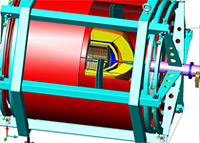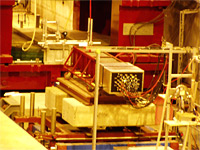 |
 |
|||||||||||||
|
|||||||||||||
|
|||||||||||||
In July, ILC NewsLine provided overviews of the four detector concepts and of the Global Large Detector (GLD) concept. In October and November we took a closer look at the Silicon Detector (SiD) concept and the Large Detector Concept LDC. This week features the last ILC detector concept: the '4th concept'. The newer ILC detector concept is the only one which does not rely on a particle flow algorithm for event reconstruction. "The only similarity between our calorimeter and those of the other concepts is that we call it a calorimeter, the idea is totally different," said John Hauptman, physicist at Iowa State University, contact person for the '4th concept'. At the ILC, good energy resolution is crucial to understand which kinds of events were produced at one e+ e- interaction point. The '4th concept' calorimeter uses the newly tested principle of dual readout of both scintillation light from all charged particles and, separately, Cerenkov light predominantly from the electromagnetic particles. This technique improves the energy resolution and the measured energies are independent of particle type (photons, electrons, hadrons…). The '4th concept' is deliberately designed to be simple, consisting of four main components. From the interaction region to the outside one can find: a silicon tracker, a Time Projection Chamber (TPC), a dual readout calorimeter, and an iron-free muon spectrometer inside a dual solenoid flux return. Among these detectors, the calorimeter and the iron-free muon system are areas of innovation. The pixel vertex detector is the same design as the SiD concept and the TPC is very similar to those being developed by the GLD and the LDC concepts. Since 1997, Richard Wigmans from Texas Tech University has been working on a dual readout calorimeter called DREAM (Dual-REAdout Module). "This DREAM project originated from the lessons we learned from the prototype studies for the Forward Calorimeter of the CMS experiment at LHC led by Nural Akchurin (Texas Tech University), an iron absorber with quartz fibres that measured only Cerenkov light," said Hauptman. The '4th concept', which includes the DREAM calorimeter, was first proposed at the ILC Snowmass meeting in August 2005. This new calorimeter has fine spatial sampling with two kinds of fibres. Scintillating fibres measure spatial fluctuations and Cerenkov fibres measure predominantly the ultra-relativistic electrons, which will lower the uncertainty on the electromagnetic fraction of the particle showers (electrons, positrons and photons). Particle identification is easier with a dual readout calorimeter since each shower, whether electromagnetic, hadronic or radiative muon, is measured in two separate ways, revealing complementary and contrasting aspects. These separate measurements allow the calorimeter alone to distinguish particle types. The '4th concept' group plans to measure the MeV neutrons liberated in each shower to further improve hadronic energy resolution. This could be accomplished with a third fibre, by a time history readout of the dual fibres, or by some other technique. For the muon system, the '4th concept' has designed a new dual-solenoid geometry. Its cylindrical form recalls the geometry of the CMS solenoid at LHC. The idea is to have two solenoids. The inner one provides the uniform tracking field. The outer one returns the flux and, at the same time, provides a moderately uniform field for a second muon bending and precision momentum measurement after the calorimeter. "This muon system is iron-free, which helps a lot in the simplicity of our concept: it will allow us to mount all beam line elements on a single support," said Alexander Mikhailichenko, Cornell University and the machine-detector interface expert on the '4th concept' . "It will also reduce the effects of vibrations at the final focus," Mikhailichenko added. The relative simplicity and low mass of this iron-free detector will allow for an easier push-pull, ease of installation and future modification, and possibly lower cost. The '4th concept' involves scientists and engineers from America, Asia and Europe almost in equal proportion. So far, about 20 people are working on the DREAM calorimeter. The team is already international since collaborators come from Italy, CERN, Romania, USA, Korea, Ukraine, Turkey and China. There is also a large R&D effort on the muon solenoids with 10 people involved from three countries. As every detector concept, there are also important studies ongoing on machine detector interface issues. There is no specific development on pixel detectors and TPC trackers for this concept, but the '4th concept' group has close ties to different R&D collaboration like the Linear Collider TPC group (LC-TPC) and silicon detectors for the linear collider with the group at Fermilab. "We are very happy to be included in the Detector Concept Report that will be released next February," said Hauptman, "even though we are not a full concept yet." "Diversity at this stage is valuable for the project," added Mikhailichenko. -- Perrine Royole-Degieux |
|||||||||||||
| © International Linear Collider |

